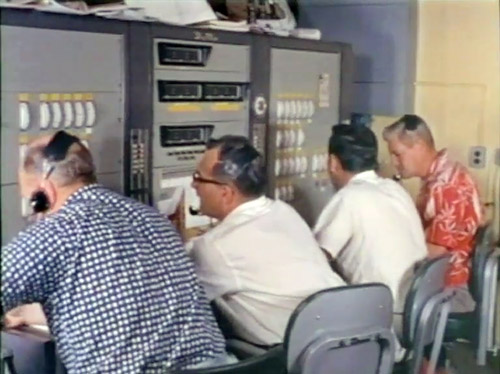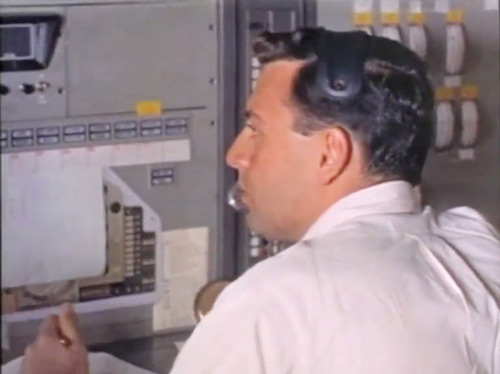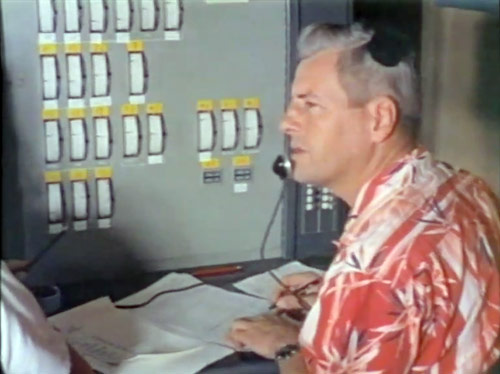For the Project Mercury missions, teams of Flight Controllers were deployed from Mercury Control at the Cape to each of the remote tracking sites.
Generally, a team consisted of a Capcom (Capsule Communicator – often another Astronaut), a Systems Engineer, and an Aeromedical Monitor (or Flight Surgeon).
Often, backups were included for each position.
The visiting team were supported, of course, by the local station staff. The visiting teams were often at the remote sites for extended periods, including for simulations and delays in launches.
While the worldwide communications network for Project Mercury was a wonder of modern telecommunications for the time, it could not be relied on the allow real time control from Mercury Control at the Cape – especially to remote sites like Woomera, or the tracking ships. (Listen to this MA-6 audio recorded at Muchea, this MA-9 audio recorded at Woomera, as well as this GT-3 audio recorded at Carnarvon, to get a feel for the difficulty of communications between the remote sites and the Cape.)
This was the driving reason behind the need to deploy the Flight Control Teams.
This deployment continued right throught the Gemini Program, and early tests for Apollo also had flight control consoles installed at Carnarvon and other sites.
By the time the manned Apollo missions flew, NASCOM had evolved to such an extent that all flight control operations could be carried out from the new Mission Control Centre in Houston (MCC-H came online for Gemini 4).
(In time, we hope to add a list of all flight control teams to visit Australia during Mercury and Gemini.)
|
This Department of Supply silent footage was shot in late 1961 or early 1962, as the NASA tracking network prepared for Friendship 7.
The same team of Flight Controllers was posted at Red Lake for MA-5 (the flight of Enos the Chimp) in November 1961, and MA-6 / Friendship 7 (John Glenn's three-orbit flight).
The audio was recorded at Red Lake, and preserved by Bill Miller. The audio used here is from the second orbit, with the exception of the comms check from Gene Kranz at the Cape at the start of the video – that was before acquisition on John Glenn’s first orbit. (Hear the full audio.)
Thanks to Glen Nagle at CDSCC for his loan of the S-VHS tapes with the archival footage, and to Ian Mackenzie for the transfer to digital format.
Thanks also to – Bill Miller for the audio, and for his transparency of the T&C building; Jan Delgado for her transparency of the FPS-16 radar; Gene Kranz, Dr Edwin M. Overholt and to Manfred “Dutch” von Ehrenfried for help with identification.
Watch above, on Vimeo, or download a smaller, 47MB, file here.
|
Below are some stills from the footage:
|
Front to back, at the Red Lake Command Console:
Dr John Lane (Australian Flight Surgeon)
Dr Edwin L Overholt (NASA Flight Surgeon)
Fred Volpe (Woomera Capcom – NASA)
Larry Wafford (Woomera Systems – NASA/ Philco).
From silent film taken around the time of MA5 (Enos the Chimp) in November 1961. The same team were at Red Lake for MA6. |
|
Left to right, at the Red Lake Command Console:
Dr John Lane (Australian Flight Surgeon)
Dr Edwin L Overholt (NASA Flight Surgeon)
Fred Volpe (Woomera Capcom – NASA)
Larry Wafford (Woomera Systems – NASA / Philco).
|
|
Dr John Lane (Australian Flight Surgeon) and Dr Edwin L Overholt (NASA Flight Surgeon).
|
|
Fred Volpe (Woomera Capcom).
|
|
Larry Wafford (Woomera Systems). |
Screenshots and identification by Colin Mackellar.




